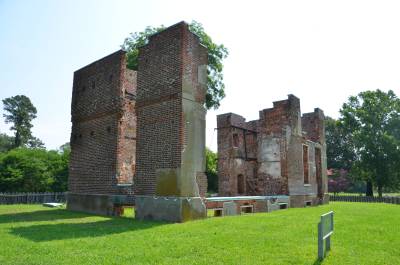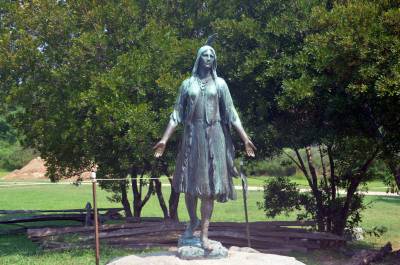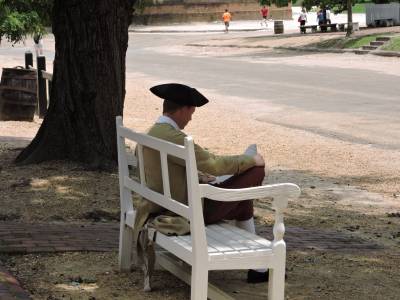Back in history - and forward once more
A day of history. Many of the previous days had involved history-moments, but this day was dedicated to history. We were going to visit a few places in the area, where we stayed, that is the peninsula between York and James rivers. This is where English colonists first settled, when they arrived in North America. Actually this is not true. English colonmist had already tried to establish themselves in what is now North Carolina, when Queen Elizabeth I granted Sir Francis Drake some land there, but the settlements disappeared again, so who cares? Anyway Jamestown, our first goal of the day, became the first permanent English settlement in Virginia.
 As looking at historic places was all we had to do, we didn't leave the
hotel until 9.30 in the morning. You can get from Williamsburg to Jamestown in
more ways than one, but we decided for the most scenic route, The Colonial
Historic Parkway. This road leads through forest and marshes, crosses streams and
runs along a narrow isthmus that leads from the mainland to Jamestown Island.
Here, driving along the water, we saw a lot of geese, some bald eagles and other
birds. Very impressive. All in all the drive from our hotel to Historic
Jamestowne, out first goal of the day was around 12 miles, and we arrived right
before
10.
As looking at historic places was all we had to do, we didn't leave the
hotel until 9.30 in the morning. You can get from Williamsburg to Jamestown in
more ways than one, but we decided for the most scenic route, The Colonial
Historic Parkway. This road leads through forest and marshes, crosses streams and
runs along a narrow isthmus that leads from the mainland to Jamestown Island.
Here, driving along the water, we saw a lot of geese, some bald eagles and other
birds. Very impressive. All in all the drive from our hotel to Historic
Jamestowne, out first goal of the day was around 12 miles, and we arrived right
before
10.
Historic Jamestowne is an archaeological excavation site, on the site of the first where the first Englishmen settled permanently in Northamerica. The entrance to the area is through Historic Jamestowne Visitor Center and Museum, so we spent some time, looking af the exhibitions. Historic Jamestowne is a National Historic Site managed by the National Park Service. This year we hadn't bought an annual pass, so we had to pay the rather modest fee of $ 14 per adult (July 2014). When we had enjoyed the museum for a while, we went out on the field.
From the museum building you follow a plank covered path across the marsh for 500 feet or so to the archaeological field. Here three ships arrived with English settlers in 1607, and here they founded the first settlement, James Fort, later renamed to Jamestowne. Names after James I, who was the ruling English king at the time of the settlement. In the following years the fort developed into a rather large town. Jamestowne became the capital of the colony, and served as such until 1699. Through the next couple of hundred years, the town flourished, but gradually it's importance diminished, and so did the town itself. In the 19th century the town had disappeared and the area, where it once stood was used for agricultural purposes. During the Civil War, defenses were built in the area, to help protect Richmond from attacks from Union troop. Near the end of the century, it was decided to try to preserve the historic site for posterity, and the owner of the area, donated a large tract of land, were ruins were still visible. Excavations were started on a low level basis. In 1966 the area was listed in National Register of Historic Places, and today it has become a National Historic Site. In 1994 excavations started for real, and large parts of the place is excavated, and diggings are still taking place.
 We toured the area
and looked at the many remains. Most of them are from the 17 and 18 hundreds,
and most are only foundations, but the tower of the church is original even
though the church is a replica. Also the walls of Ambler House from 1750 are
still standing. We passed an active excavation and looked at the people who were busy
digging. Besides the historic remains, a couple of statues are raised in the
area. One of John Smith, first governor of Virginia and one of Indian princess
Pocahontas, that allegedly saved Smiths life. If she really did is uncertain.
What is almost certain though, is that they were not in love as depicted in the
Disney animated picture or the movie The New World. Smith was in his thirties
and Pocahontas was only 11 or 12 at the time. The statue depicts her somewhat
older though.
We toured the area
and looked at the many remains. Most of them are from the 17 and 18 hundreds,
and most are only foundations, but the tower of the church is original even
though the church is a replica. Also the walls of Ambler House from 1750 are
still standing. We passed an active excavation and looked at the people who were busy
digging. Besides the historic remains, a couple of statues are raised in the
area. One of John Smith, first governor of Virginia and one of Indian princess
Pocahontas, that allegedly saved Smiths life. If she really did is uncertain.
What is almost certain though, is that they were not in love as depicted in the
Disney animated picture or the movie The New World. Smith was in his thirties
and Pocahontas was only 11 or 12 at the time. The statue depicts her somewhat
older though.
Since our visit to Dooley-land a couple of days earlier, we hadn't visited any cemeteries, so we spent some time looking at the burial site of the first settlers, and a few other graves in the area. We would compensate for this lack of cemeteries already the very next day. When we had seen enough we slowly walked back to the museum. Slowly, because of the temperature and not least the humidity. The temperature was around 95 and so was the humidity. We returned to the car and continued our historic day.
We did so by driving to Jamestown Settlement, a "living history museum" about 1.3 miles from Historic Jamestowne. Here a replica of James Fort are build and also some other buildings in- and outside the fort. You can also visit a Powhatan village, and replicas of the three ships, that took the settlers to Northamerica. This place has nothing to do with Historic Jamestowne but is run by The Commonwealth of Virginia. That meant we had to pay an entrance fee once more, this time $ 16. We looked at the indoor museum before heading outside. The employees are dressed in 18th century dresses, and that is already interesting :-). Our first visit was to the Powhatan village, where we entered a cottage, but nothing here really interested us, so we continued to the harbor.
Here we went onboard two of the ships, the smallest, Discovery and the largest, Susan Constant. On board the latter, we went under deck. Down here an old man, dressed as a mariner (he looked as if he had actually arrived in 1607) told interesting stories to a small audience, mostly kids and their parents. After our visit to the ships, we walked to the replica of the old fort. Most forts I have seen previously are square, but this one is trianular for some reason. We visited a blacksmith shop, the church, and some other buildings before walking back to the entrance. We returned to Williamsburg the same way, that we had arrived, as I wanted some pictures of the bald eagles, but they had disappeared. Maybe taking a coffee brak or whatever birds like that do around 2.30 in the afternoon.
 Back
in Williamsburg we drove to the Colonial Williamsburg Visitor Center only to
discover, that this "living history museum" charges $ 50 per person, for a 5-6
miles long walk up and down the streets - and entrance to some buildings. Here
our inner miser arose from inside, and we declined. Instead we drove to Francis Street near
main street, called Duke of Gloucester Street. From the parking lot we walked to
main street and found King's Arms Tavern, where we had booked a
table for tonight's dinner, and confirmed our reservation. We took a short walk
up and down main street and looked at the costumed inhabitants (or actors), and
looked at the old statehouse at the end of the street. Williamsburg became the
capital of Virginia in 1699, when it took over from Jamestown and a new
government building was completed in 1705. Actually the building now there, is a replica
of the first statehouse, that stood on the spot from 1705 until it burned down
in 1747. The later statehouse, that served from 1747 until 1779, when the capital
moved to Richmond is long gone. It was in this, now disappeared statehouse that
many of the famous early politicians from Virginia met. People like George Washington,
Thomas Jefferson (last govenor of the colony of Virginia), Patrick Henry (first
governor of the state of Virginia) and many others.
Back
in Williamsburg we drove to the Colonial Williamsburg Visitor Center only to
discover, that this "living history museum" charges $ 50 per person, for a 5-6
miles long walk up and down the streets - and entrance to some buildings. Here
our inner miser arose from inside, and we declined. Instead we drove to Francis Street near
main street, called Duke of Gloucester Street. From the parking lot we walked to
main street and found King's Arms Tavern, where we had booked a
table for tonight's dinner, and confirmed our reservation. We took a short walk
up and down main street and looked at the costumed inhabitants (or actors), and
looked at the old statehouse at the end of the street. Williamsburg became the
capital of Virginia in 1699, when it took over from Jamestown and a new
government building was completed in 1705. Actually the building now there, is a replica
of the first statehouse, that stood on the spot from 1705 until it burned down
in 1747. The later statehouse, that served from 1747 until 1779, when the capital
moved to Richmond is long gone. It was in this, now disappeared statehouse that
many of the famous early politicians from Virginia met. People like George Washington,
Thomas Jefferson (last govenor of the colony of Virginia), Patrick Henry (first
governor of the state of Virginia) and many others.
We returned to the hotel and relaxed until 7.30. Then we returned to the parking lot in Francis Street, and walked the charming streets to King's Arms Tavern. The tavern originally opened in 1772, but has been renovated a couple of times since then. The building has been used for other purposes in the meantime, but now it's a tavern once more. When we booked our dinner back home, we had wavered between this place and Christina Campbell's Tavern (George Washington's favorite seafood restaurant), where Tim had lunched in 2005, but we finally settled on the King's Arms. The servers were dressed en 18th century clothes and so were the entertaining musicians, and the music was also from the period. The food was great, Tim had Hunter's Pye and I something that was called Duelling Beef. For starters we both had salad with smoked salmon and everything was excellent. It was the most expensive meal on the trip so far, ($ 125 + tips), but well worth every penny.
After dinner we returned to the car and drove back to the hotel to relax and prepare next day's drive to Washington DC.